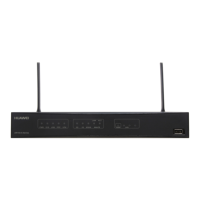#
interface Ethernet 0/0/0
port hybrid tagged vlan 10
#
interface Ethernet 0/0/1
port hybrid tagged vlan 20
#
interface Ethernet 0/0/2
port hybrid tagged vlan 30
##
interface Vlanif 10
ip address 10.2.2.2 255.255.255.0
#
interface Ethernet 2/0/0
ip address 10.164.10.10 255.255.255.0
#
arp static 10.164.1.1 00e0-fc01-0001 vid 10 interface ethernet 0/0/0
arp static 10.164.1.2 00e0-fc01-0002 vid 10 interface ethernet 0/0/0
arp static 10.164.1.3 00e0-fc01-0003 vid 10 interface ethernet 0/0/0
arp static 10.164.10.1 0df0-fc01-003a
#
return
1.11.2 Example for Configuring Routed Proxy ARP
Routed proxy ARP implements communication between the two branches on the same network
segment but on different physical networks.
Networking Requirements
As shown in Figure 1-2, branch A and branch B of a company are located in different cities;
multiple routing devices are deployed between branches and routes are reachable; IP addresses
of the routing devices are on the same network segment 172.16.0.0/16. Branch A and branch B
belong to different broadcast domains; therefore, they cannot communicate on a LAN. Hosts of
branches are not configured with default gateway addresses; therefore, they cannot communicate
across network segments. The company requires that branch A and branch B communicate
without changing the host configurations.
NOTE
AR150/200 is RouterA or RouterB.
Figure 1-2 Network diagram for configuring routed proxy ARP
Branch A
RouterA
RouterB
RouterC
RouterD
VLAN10
VLAN20
Internet
Host A
172.16.1.2/16
0000-5e33-ee20
Host B
172.16.2.2/16
0000-5e33-ee10
Etherent0/0/0
Etherent0/0/0
Branch B
Huawei AR150&200 Series Enterprise Routers
Configuration Guide - IP Service 1 ARP Configuration
Issue 02 (2012-03-30) Huawei Proprietary and Confidential
Copyright © Huawei Technologies Co., Ltd.
27

